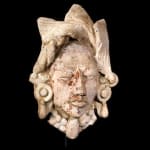Mayan Late Classic Period Lime Stucco Head, 600 CE - 900 CE
Stucco
11.5
PF.0416
This imposing sculpture was designed and executed to adorn a wall in some part of the Maya Empire, which sprawled across southern Mexico, Guatemala, Belize, El Salvador, western Honduras and...
This imposing sculpture was designed and executed to adorn a wall in some part of the Maya Empire, which sprawled across southern Mexico, Guatemala, Belize, El Salvador, western Honduras and the Yucatán Peninsula. Despite being intensely vulnerable to natural disasters, this notoriously changeable area produced one of the foremost civilisations of the New World, with technological and cultural advances that far outstripped their neighbours and contemporary societies much farther afield.
The Classic period, to which this piece belongs, dates from the mid third to the ninth centuries AD, based on intensive agriculture, specialist production and trade (in obsidian, pelts and jade) between neighbouring city-states and across the American continents. The Maya erected the tallest buildings that would be seen in the Americas until the 19th century AD. This timeframe saw a flowering of artistic and scientific endeavour, including the development of a glyph-based literary system that has allowed academics to precisely date historical events, as the Mayans also developed the only reliable calendrical system in the New World.
The stories of creation, beliefs and social information we have for the Maya allows us to reconstruct many of their rituals and practices, combined with archaeological information about economy and the people themselves – for instance, they were much given to the habit of deforming the skulls of their children using strapping and wood boards, in order to produce an elongated shape. They were also enthusiastic about blood-letting, which they used as a gesture of obedience to new rulers, sometimes letting so much blood from their tongues and genitalia (using ropes strung with stingray spines) that entire cities became anaemic. The walls of Maya structures are always decorated in bright colours (often the famous “Maya Blue”), with relief glyphs and stucco designs that included anthropomorphic designs such as this.
The head depicts a young noble, as evidenced by his pendulous ear ornaments, gorget (neck jewellery) and ornate hair. It appears that his skull was deformed in infancy in order to provide the elongated look so beloved of the Maya aristocracy. The face is set into a harmonious composition with heavy lids, a pensive expression and a long nose leading to slightly pursed lips. The coiffure is arranged into a sequential wave pattern that flows from left to right, each piece being painstakingly carved with incised grooves. The ear ornaments are circular, with pendulous addenda, and the gorget is made up of a large central pendant supported by a double string of large beads which act as a choker. The face appears monochrome in the colour of the stucco, but was in fact once painted as there are flecks of red and Maya Blue – (the recipe for which was lost in the 16th century) – around the minor incised details and the jewellery. This is a mature, reflective and powerfully executed piece from the high point of Maya culture, and a beautiful addition to any serious collection of Pre-Columbian art.
The Classic period, to which this piece belongs, dates from the mid third to the ninth centuries AD, based on intensive agriculture, specialist production and trade (in obsidian, pelts and jade) between neighbouring city-states and across the American continents. The Maya erected the tallest buildings that would be seen in the Americas until the 19th century AD. This timeframe saw a flowering of artistic and scientific endeavour, including the development of a glyph-based literary system that has allowed academics to precisely date historical events, as the Mayans also developed the only reliable calendrical system in the New World.
The stories of creation, beliefs and social information we have for the Maya allows us to reconstruct many of their rituals and practices, combined with archaeological information about economy and the people themselves – for instance, they were much given to the habit of deforming the skulls of their children using strapping and wood boards, in order to produce an elongated shape. They were also enthusiastic about blood-letting, which they used as a gesture of obedience to new rulers, sometimes letting so much blood from their tongues and genitalia (using ropes strung with stingray spines) that entire cities became anaemic. The walls of Maya structures are always decorated in bright colours (often the famous “Maya Blue”), with relief glyphs and stucco designs that included anthropomorphic designs such as this.
The head depicts a young noble, as evidenced by his pendulous ear ornaments, gorget (neck jewellery) and ornate hair. It appears that his skull was deformed in infancy in order to provide the elongated look so beloved of the Maya aristocracy. The face is set into a harmonious composition with heavy lids, a pensive expression and a long nose leading to slightly pursed lips. The coiffure is arranged into a sequential wave pattern that flows from left to right, each piece being painstakingly carved with incised grooves. The ear ornaments are circular, with pendulous addenda, and the gorget is made up of a large central pendant supported by a double string of large beads which act as a choker. The face appears monochrome in the colour of the stucco, but was in fact once painted as there are flecks of red and Maya Blue – (the recipe for which was lost in the 16th century) – around the minor incised details and the jewellery. This is a mature, reflective and powerfully executed piece from the high point of Maya culture, and a beautiful addition to any serious collection of Pre-Columbian art.
Literature
V2



